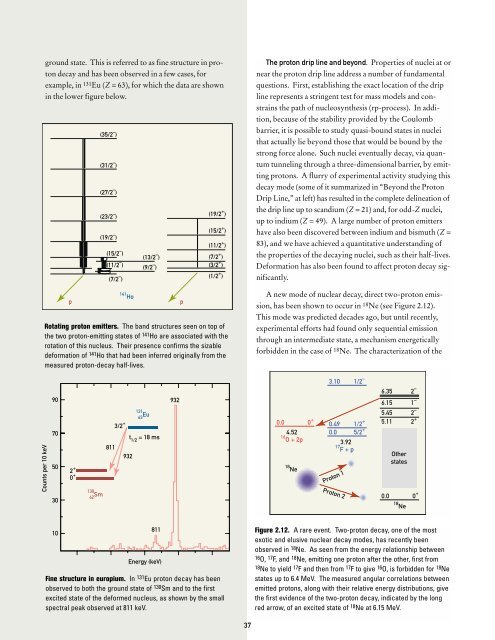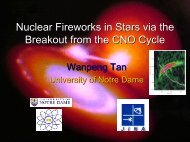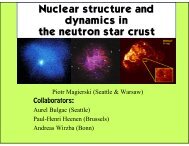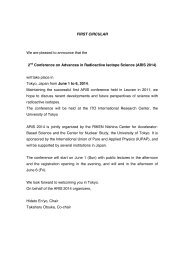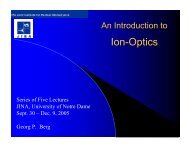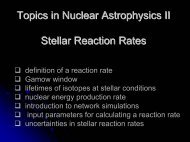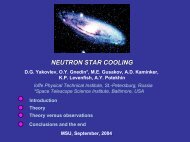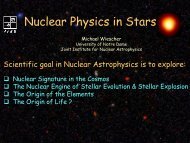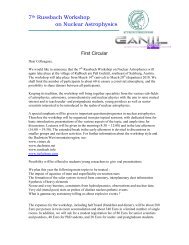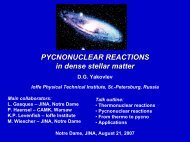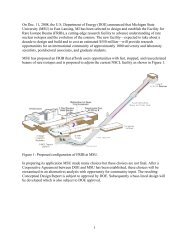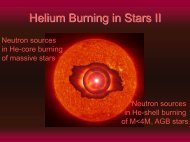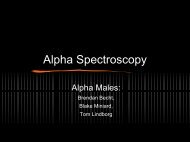OPPORTUNITIES IN NUCLEAR SCIENCE A Long-Range Plan for ...
OPPORTUNITIES IN NUCLEAR SCIENCE A Long-Range Plan for ...
OPPORTUNITIES IN NUCLEAR SCIENCE A Long-Range Plan for ...
Create successful ePaper yourself
Turn your PDF publications into a flip-book with our unique Google optimized e-Paper software.
ground state. This is referred to as fine structure in proton<br />
decay and has been observed in a few cases, <strong>for</strong><br />
example, in 131 Eu (Z = 63), <strong>for</strong> which the data are shown<br />
in the lower figure below.<br />
p<br />
(35/2 – )<br />
(31/2 – )<br />
(27/2 – )<br />
(23/2 – )<br />
(19/2 – )<br />
(15/2 – )<br />
(11/2 – )<br />
(7/2 – )<br />
141 Ho<br />
(13/2 – )<br />
(9/2 – )<br />
p<br />
(19/2 + )<br />
(15/2 + )<br />
(11/2 + )<br />
(7/2 + )<br />
(3/2 + )<br />
(1/2 + )<br />
Rotating proton emitters. The band structures seen on top of<br />
the two proton-emitting states of 141 Ho are associated with the<br />
rotation of this nucleus. Their presence confirms the sizable<br />
de<strong>for</strong>mation of 141 Ho that had been inferred originally from the<br />
measured proton-decay half-lives.<br />
The proton drip line and beyond. Properties of nuclei at or<br />
near the proton drip line address a number of fundamental<br />
questions. First, establishing the exact location of the drip<br />
line represents a stringent test <strong>for</strong> mass models and constrains<br />
the path of nucleosynthesis (rp-process). In addition,<br />
because of the stability provided by the Coulomb<br />
barrier, it is possible to study quasi-bound states in nuclei<br />
that actually lie beyond those that would be bound by the<br />
strong <strong>for</strong>ce alone. Such nuclei eventually decay, via quantum<br />
tunneling through a three-dimensional barrier, by emitting<br />
protons. A flurry of experimental activity studying this<br />
decay mode (some of it summarized in “Beyond the Proton<br />
Drip Line,” at left) has resulted in the complete delineation of<br />
the drip line up to scandium (Z = 21) and, <strong>for</strong> odd-Z nuclei,<br />
up to indium (Z = 49). A large number of proton emitters<br />
have also been discovered between indium and bismuth (Z =<br />
83), and we have achieved a quantitative understanding of<br />
the properties of the decaying nuclei, such as their half-lives.<br />
De<strong>for</strong>mation has also been found to affect proton decay significantly.<br />
A new mode of nuclear decay, direct two-proton emission,<br />
has been shown to occur in 18 Ne (see Figure 2.12).<br />
This mode was predicted decades ago, but until recently,<br />
experimental ef<strong>for</strong>ts had found only sequential emission<br />
through an intermediate state, a mechanism energetically<br />
<strong>for</strong>bidden in the case of 18 Ne. The characterization of the<br />
Counts per 10 keV<br />
90<br />
70<br />
50<br />
30<br />
131<br />
63 Eu<br />
3/2 +<br />
t 1/2 = 18 ms<br />
811<br />
932<br />
2 +<br />
0 + 130<br />
62 Sm<br />
932<br />
3.10 1/2 – 6.35 2 –<br />
6.15 1 –<br />
5.45 2 –<br />
0.0 0 + 0.49 1/2 + 5.11 2 +<br />
4.52<br />
0.0 5/2 +<br />
16 O + 2p 3.92<br />
17 F + p<br />
Other<br />
states<br />
18 Ne<br />
0.0 0 +<br />
18 Ne<br />
Proton 1<br />
Proton 2<br />
10<br />
811<br />
Energy (keV)<br />
Fine structure in europium. In 131 Eu proton decay has been<br />
observed to both the ground state of 130 Sm and to the first<br />
excited state of the de<strong>for</strong>med nucleus, as shown by the small<br />
spectral peak observed at 811 keV.<br />
Figure 2.12. A rare event. Two-proton decay, one of the most<br />
exotic and elusive nuclear decay modes, has recently been<br />
observed in 18 Ne. As seen from the energy relationship between<br />
16 O, 17 F, and 18 Ne, emitting one proton after the other, first from<br />
18 Ne to yield 17 F and then from 17 F to give 16 O, is <strong>for</strong>bidden <strong>for</strong> 18 Ne<br />
states up to 6.4 MeV. The measured angular correlations between<br />
emitted protons, along with their relative energy distributions, give<br />
the first evidence of the two-proton decay, indicated by the long<br />
red arrow, of an excited state of 18 Ne at 6.15 MeV.<br />
37


